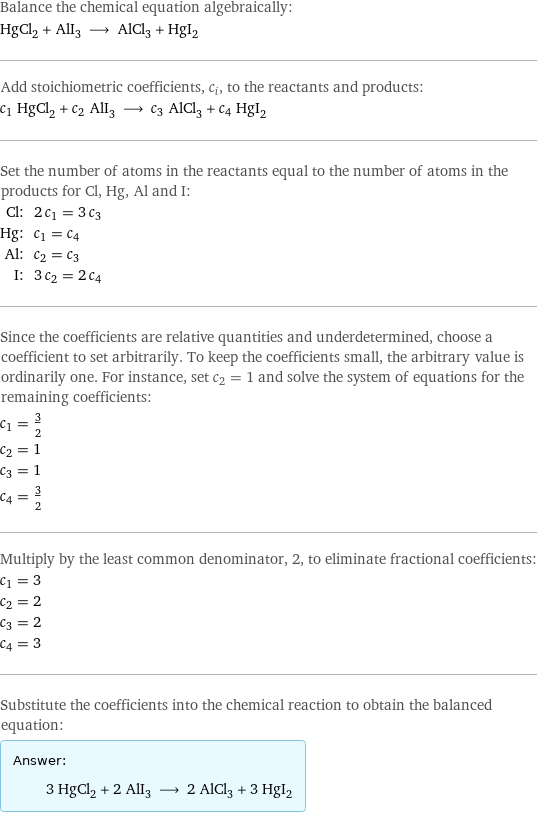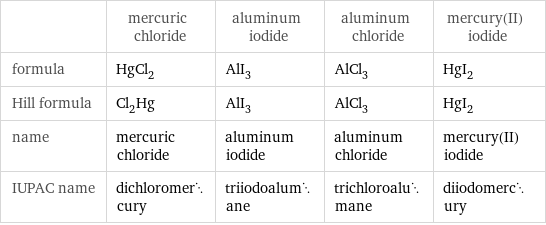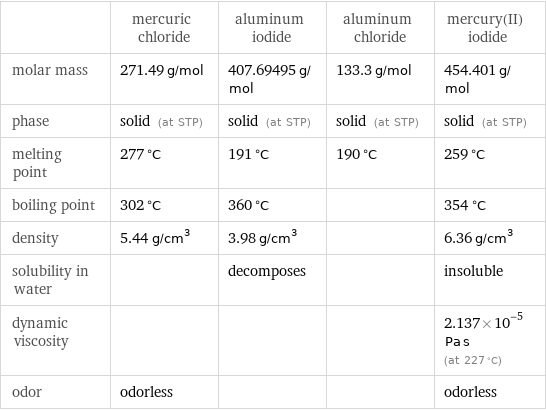Input interpretation

HgCl_2 mercuric chloride + AlI_3 aluminum iodide ⟶ AlCl_3 aluminum chloride + HgI_2 mercury(II) iodide
Balanced equation

Balance the chemical equation algebraically: HgCl_2 + AlI_3 ⟶ AlCl_3 + HgI_2 Add stoichiometric coefficients, c_i, to the reactants and products: c_1 HgCl_2 + c_2 AlI_3 ⟶ c_3 AlCl_3 + c_4 HgI_2 Set the number of atoms in the reactants equal to the number of atoms in the products for Cl, Hg, Al and I: Cl: | 2 c_1 = 3 c_3 Hg: | c_1 = c_4 Al: | c_2 = c_3 I: | 3 c_2 = 2 c_4 Since the coefficients are relative quantities and underdetermined, choose a coefficient to set arbitrarily. To keep the coefficients small, the arbitrary value is ordinarily one. For instance, set c_2 = 1 and solve the system of equations for the remaining coefficients: c_1 = 3/2 c_2 = 1 c_3 = 1 c_4 = 3/2 Multiply by the least common denominator, 2, to eliminate fractional coefficients: c_1 = 3 c_2 = 2 c_3 = 2 c_4 = 3 Substitute the coefficients into the chemical reaction to obtain the balanced equation: Answer: | | 3 HgCl_2 + 2 AlI_3 ⟶ 2 AlCl_3 + 3 HgI_2
Structures

+ ⟶ +
Names

mercuric chloride + aluminum iodide ⟶ aluminum chloride + mercury(II) iodide
Equilibrium constant
![Construct the equilibrium constant, K, expression for: HgCl_2 + AlI_3 ⟶ AlCl_3 + HgI_2 Plan: • Balance the chemical equation. • Determine the stoichiometric numbers. • Assemble the activity expression for each chemical species. • Use the activity expressions to build the equilibrium constant expression. Write the balanced chemical equation: 3 HgCl_2 + 2 AlI_3 ⟶ 2 AlCl_3 + 3 HgI_2 Assign stoichiometric numbers, ν_i, using the stoichiometric coefficients, c_i, from the balanced chemical equation in the following manner: ν_i = -c_i for reactants and ν_i = c_i for products: chemical species | c_i | ν_i HgCl_2 | 3 | -3 AlI_3 | 2 | -2 AlCl_3 | 2 | 2 HgI_2 | 3 | 3 Assemble the activity expressions accounting for the state of matter and ν_i: chemical species | c_i | ν_i | activity expression HgCl_2 | 3 | -3 | ([HgCl2])^(-3) AlI_3 | 2 | -2 | ([AlI3])^(-2) AlCl_3 | 2 | 2 | ([AlCl3])^2 HgI_2 | 3 | 3 | ([HgI2])^3 The equilibrium constant symbol in the concentration basis is: K_c Mulitply the activity expressions to arrive at the K_c expression: Answer: | | K_c = ([HgCl2])^(-3) ([AlI3])^(-2) ([AlCl3])^2 ([HgI2])^3 = (([AlCl3])^2 ([HgI2])^3)/(([HgCl2])^3 ([AlI3])^2)](../image_source/72e351d50d0e135cc76f08d1f8ff1291.png)
Construct the equilibrium constant, K, expression for: HgCl_2 + AlI_3 ⟶ AlCl_3 + HgI_2 Plan: • Balance the chemical equation. • Determine the stoichiometric numbers. • Assemble the activity expression for each chemical species. • Use the activity expressions to build the equilibrium constant expression. Write the balanced chemical equation: 3 HgCl_2 + 2 AlI_3 ⟶ 2 AlCl_3 + 3 HgI_2 Assign stoichiometric numbers, ν_i, using the stoichiometric coefficients, c_i, from the balanced chemical equation in the following manner: ν_i = -c_i for reactants and ν_i = c_i for products: chemical species | c_i | ν_i HgCl_2 | 3 | -3 AlI_3 | 2 | -2 AlCl_3 | 2 | 2 HgI_2 | 3 | 3 Assemble the activity expressions accounting for the state of matter and ν_i: chemical species | c_i | ν_i | activity expression HgCl_2 | 3 | -3 | ([HgCl2])^(-3) AlI_3 | 2 | -2 | ([AlI3])^(-2) AlCl_3 | 2 | 2 | ([AlCl3])^2 HgI_2 | 3 | 3 | ([HgI2])^3 The equilibrium constant symbol in the concentration basis is: K_c Mulitply the activity expressions to arrive at the K_c expression: Answer: | | K_c = ([HgCl2])^(-3) ([AlI3])^(-2) ([AlCl3])^2 ([HgI2])^3 = (([AlCl3])^2 ([HgI2])^3)/(([HgCl2])^3 ([AlI3])^2)
Rate of reaction
![Construct the rate of reaction expression for: HgCl_2 + AlI_3 ⟶ AlCl_3 + HgI_2 Plan: • Balance the chemical equation. • Determine the stoichiometric numbers. • Assemble the rate term for each chemical species. • Write the rate of reaction expression. Write the balanced chemical equation: 3 HgCl_2 + 2 AlI_3 ⟶ 2 AlCl_3 + 3 HgI_2 Assign stoichiometric numbers, ν_i, using the stoichiometric coefficients, c_i, from the balanced chemical equation in the following manner: ν_i = -c_i for reactants and ν_i = c_i for products: chemical species | c_i | ν_i HgCl_2 | 3 | -3 AlI_3 | 2 | -2 AlCl_3 | 2 | 2 HgI_2 | 3 | 3 The rate term for each chemical species, B_i, is 1/ν_i(Δ[B_i])/(Δt) where [B_i] is the amount concentration and t is time: chemical species | c_i | ν_i | rate term HgCl_2 | 3 | -3 | -1/3 (Δ[HgCl2])/(Δt) AlI_3 | 2 | -2 | -1/2 (Δ[AlI3])/(Δt) AlCl_3 | 2 | 2 | 1/2 (Δ[AlCl3])/(Δt) HgI_2 | 3 | 3 | 1/3 (Δ[HgI2])/(Δt) (for infinitesimal rate of change, replace Δ with d) Set the rate terms equal to each other to arrive at the rate expression: Answer: | | rate = -1/3 (Δ[HgCl2])/(Δt) = -1/2 (Δ[AlI3])/(Δt) = 1/2 (Δ[AlCl3])/(Δt) = 1/3 (Δ[HgI2])/(Δt) (assuming constant volume and no accumulation of intermediates or side products)](../image_source/e783458b5b3a689fb12573f2cde749e0.png)
Construct the rate of reaction expression for: HgCl_2 + AlI_3 ⟶ AlCl_3 + HgI_2 Plan: • Balance the chemical equation. • Determine the stoichiometric numbers. • Assemble the rate term for each chemical species. • Write the rate of reaction expression. Write the balanced chemical equation: 3 HgCl_2 + 2 AlI_3 ⟶ 2 AlCl_3 + 3 HgI_2 Assign stoichiometric numbers, ν_i, using the stoichiometric coefficients, c_i, from the balanced chemical equation in the following manner: ν_i = -c_i for reactants and ν_i = c_i for products: chemical species | c_i | ν_i HgCl_2 | 3 | -3 AlI_3 | 2 | -2 AlCl_3 | 2 | 2 HgI_2 | 3 | 3 The rate term for each chemical species, B_i, is 1/ν_i(Δ[B_i])/(Δt) where [B_i] is the amount concentration and t is time: chemical species | c_i | ν_i | rate term HgCl_2 | 3 | -3 | -1/3 (Δ[HgCl2])/(Δt) AlI_3 | 2 | -2 | -1/2 (Δ[AlI3])/(Δt) AlCl_3 | 2 | 2 | 1/2 (Δ[AlCl3])/(Δt) HgI_2 | 3 | 3 | 1/3 (Δ[HgI2])/(Δt) (for infinitesimal rate of change, replace Δ with d) Set the rate terms equal to each other to arrive at the rate expression: Answer: | | rate = -1/3 (Δ[HgCl2])/(Δt) = -1/2 (Δ[AlI3])/(Δt) = 1/2 (Δ[AlCl3])/(Δt) = 1/3 (Δ[HgI2])/(Δt) (assuming constant volume and no accumulation of intermediates or side products)
Chemical names and formulas

| mercuric chloride | aluminum iodide | aluminum chloride | mercury(II) iodide formula | HgCl_2 | AlI_3 | AlCl_3 | HgI_2 Hill formula | Cl_2Hg | AlI_3 | AlCl_3 | HgI_2 name | mercuric chloride | aluminum iodide | aluminum chloride | mercury(II) iodide IUPAC name | dichloromercury | triiodoalumane | trichloroalumane | diiodomercury
Substance properties

| mercuric chloride | aluminum iodide | aluminum chloride | mercury(II) iodide molar mass | 271.49 g/mol | 407.69495 g/mol | 133.3 g/mol | 454.401 g/mol phase | solid (at STP) | solid (at STP) | solid (at STP) | solid (at STP) melting point | 277 °C | 191 °C | 190 °C | 259 °C boiling point | 302 °C | 360 °C | | 354 °C density | 5.44 g/cm^3 | 3.98 g/cm^3 | | 6.36 g/cm^3 solubility in water | | decomposes | | insoluble dynamic viscosity | | | | 2.137×10^-5 Pa s (at 227 °C) odor | odorless | | | odorless
Units
